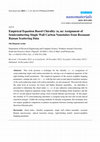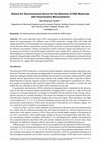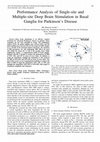Journal Papers by Md. Shamsul Arefin

This paper presents a low power, compact, and low-complexity pulse-width modulation-based interfa... more This paper presents a low power, compact, and low-complexity pulse-width modulation-based interface circuit for capacitive MEMS sensors. The circuit is designed using a ring oscillator, an RC controlled pulse generator with highpass filter, and a self-tuning inverter comparator to produce pulse width, which is proportional to differential capacitance and independent of parasitic capacitance. The high-pass filter is utilized to reduce the bandwidth of noise sources. The circuit provides control over sensitivity, dynamic range, and nominal point for the capacitance measurement by selecting controlling parameters, such as resistance of the RC pulse generator, biasing voltage of the self-tuning inverter comparator, and a reference capacitor using digital control signals. The circuit provides high linearity with higher sensitivity and lower power consumption. The sensitivity of the circuit is 0.56 to 3.62 μs/pF depending on the controlling parameters. The maximum dynamic sensing range is 22 to 270 pF depending on the controlling parameters. The interface circuit is designed and fabricated using the United Microelectronics Corporation (UMC) 0.18-μm CMOS technology. It occupies an active area of 0.17 mm2 and consumes 98 μW. A capacitive MEMS-based pressure sensor is also connected with the interface circuit to measure pressure throughout the digestive tract. The sensitivity for pressure from 101 to 200 kPa is 60 ns/kPa and from 50 to 101 kPa is 23 ns/kPa.

This paper presents an interface circuit for capacitive and inductive MEMS biosensors using an os... more This paper presents an interface circuit for capacitive and inductive MEMS biosensors using an oscillator and a charge pump based frequency-to-voltage converter. Frequency modulation using a differential crossed coupled oscillator is adopted to sense capacitive and inductive changes. The frequency-to-voltage converter is designed with a negative feedback system and external controlling parameters to adjust the sensitivity, dynamic range, and nominal point for the measurement. The sensitivity of the frequency-to-voltage converter is from 13.28 to 35.96 mV/MHz depending on external voltage and charging current. The sensitivity ranges of the capacitive and inductive interface circuit are 17.08 to 54.4 mV/pF and 32.11 to 82.88 mV/mH, respectively. A capacitive MEMS based pH sensor is also connected with the interface circuit to measure the high acidic gastric acid throughout the digestive tract. The sensitivity for pH from 1 to 3 is 191.4 mV/pH with 550 \mu V _{pp} noise. The readout circuit is designed and fabricated using the UMC 0.18 \mu m CMOS technology. It occupies an area of 0.18 mm ^2 and consumes 11.8 mW.
This work presents a microfabricated fringe-field capacitive pH sensor using interdigitated elect... more This work presents a microfabricated fringe-field capacitive pH sensor using interdigitated electrodes and an integrated modulation-based readout circuit. The changes in capacitance of the sensor result from the permittivity changes due to pH variations and are converted to frequency shifts using a crossed-coupled voltage controlled oscillator readout circuit. The shift in resonant frequency of the readout circuit is 30.96 MHz for a change in pH of 1.0–5.0. The sensor can be used for the measurement of low pH levels, such as gastric acid, and can be integrated with electronic pills. The measurement results show high repeatability, low noise, and a stable output.
Journal of Applied Physics, Mar 15, 2012
This work reports on the behavior of piezoresistive microcantilever sensors under optimizing cond... more This work reports on the behavior of piezoresistive microcantilever sensors under optimizing conditions of ac electroosmotic enhancement. Piezoresistive microcantilevers are used as sensor elements for detection of concentrated bio-particles. Without preconcentrating the samples, using ac electroosmosis, these bio-particles have been manipulated onto the piezoresistive microcantilever. A piezoresistive microcantilever senses the dimensional changes upon particle exposure as a resistance change. This paper represents the integration of ac electroosmosis with a piezoresistive micro-cantilever sensor for the detection of bio-particles. A working prototype is presented here, and the experiments are conducted on Herpes Simplex type-1 virus (HSV-1) and Escherichia Coli (E. coli) bacteria.

Advances Technologies in Nano Materials and Electric Devices http://www.scientific.net/AMR.646.202, Jan 2013
"This work represents active DNA concentration on piezoresistive microcantilever using biased AC ... more "This work represents active DNA concentration on piezoresistive microcantilever using biased AC electroosmosis. Two different sizes of DNA molecules, \alpha -phage DNA (48.5 kbp) and single-strand DNA of 20 nucleotides are concentrated on separate piezoresistive microcantilever sensor for detection. Before concentration, mixing of DNA molecules is performed using the same device for efficient concentration. During concentration of DNA molecules, biased and unbiased AC electroosmosis are needed to concentrate single-strand DNA and -phage DNA, respectively. Moreover, dielectrophoresis is induced by biased AC electroosmosis that can generate attractive force to transport negatively charged single-strand DNA. This paper represents a device configuration to integrate biased and unbiased AC electroosmosis and dielectrophoresis with piezoresistive microcantilever sensors for the detection of \alpha -phage DNA and single-strand DNA."

This work presents a technique for the chirality (n, m) assignment of semiconducting single wall ... more This work presents a technique for the chirality (n, m) assignment of semiconducting single wall carbon nanotubes by solving a set of empirical equations of the tight binding model parameters. The empirical equations of the nearest neighbor hopping parameters, relating the term (2n − m) with the first and second optical transition energies of the semiconducting single wall carbon nanotubes, are also proposed. They provide almost the same level of accuracy for lower and higher diameter nanotubes. An algorithm is presented to determine the chiral index (n, m) of any unknown semiconducting tube by solving these empirical equations using values of radial breathing mode frequency and the first or second optical transition energy from resonant Raman spectroscopy. In this paper, the chirality of 55 semiconducting nanotubes is assigned using the first and second optical transition energies. Unlike the existing methods of chirality assignment, this technique does not require graphical comparison or pattern recognition between existing experimental and theoretical Kataura plot.
Book Chapters by Md. Shamsul Arefin

Biosensors transform physiological or biological information into electrical measurements using e... more Biosensors transform physiological or biological information into electrical measurements using electronic circuits. The detected information is transmitted remotely to a data acquisition platform or a server using a wireless link for real-time monitoring and analysis. The main applications of biosensors are in wearable and implantable biomedical devices. The label-free biosensors using electrochemical and electrical transduction mechanisms such as potentiometric, amperometric, field-effect transistor, resistive, capacitive, and inductive can be developed in a small package to enable miniature point-of-care devices. The electrical properties of the biosensors are converted into voltage, frequency, or phase using various interface or readout circuit techniques. This chapter discusses the design of biosensors with wireless links for implantable or wearable sensors. A complete design example including a capacitive pH-sensor device will be discussed. The recent developments of implantable or wearable sensors using a wireless link, such as implanted wireless blood-glucose sensors, wireless capsules, and other wireless wearable devices will be presented.
Conference Presentations by Md. Shamsul Arefin

The wireless capsule has been used to measure physiological parameters in the gastrointestinal tr... more The wireless capsule has been used to measure physiological parameters in the gastrointestinal tract where communication from in-body to external receiver is necessary using a miniaturized antenna with high gain and onmidirectional radiation pattern. This paper presents a meandered conformal antenna with center frequency of 433 MHz for a wireless link between an in-body capsule system and an ex-body receiver system. The antenna is wrapped around the wireless capsule, which provides extra space for other circuits and sensors inside the capsule as well as allows it having larger dimensions compared to inner antennas. This paper analyses return loss, radiation pattern, antenna gain, and propagation loss using pork as the gastrointestinal tissue simulating medium. From the radiation pattern and return loss results, the antenna shows an omni-directional radiation pattern and an ultrawide bandwidth of 124.4 MHz (371.6 to 496 MHz) for VSWR <; 2. Experimental results shows that the path loss is 17.24 dB for an in-body propagation distance of 140 mm.
This paper presents a frequency modulation based readout circuit for the measurement of skin cond... more This paper presents a frequency modulation based readout circuit for the measurement of skin conductance or resistance. A charge pump based frequency-to-voltage converter circuit with adjustable sensitivity is used to convert the frequency shifts due to skin resistance changes into voltage variations. The readout circuit improves the measurement accuracy and artifact rejection in measurements of the galvanic skin response on the skin, and can be integrated with wearable physiological monitoring systems. The readout circuit is designed and fabricated using the UMC 0.18 μm CMOS technology. It occupies an area of 0.18 mm2 and consumes 11.7 mW.
We have developed a micro-scale chip-based pH sensing system, which can effectively measure the c... more We have developed a micro-scale chip-based pH sensing system, which can effectively measure the changes in pH ranging from 1 to 4 and 10 to 12. This method relies on fringing field capacitive measurements. A change in pH of the medium results in a permittivity change for the fringing electric field, which in turn affects the capacitance values. Capacitance changes are then converted to resonant frequency shifts via a readout circuit. This technique provides high sensitivity, low hysteresis, and low noise as well as low fabrication cost. Very importantly, the device and the corresponding measurement circuitry have the potential to be integrated in an electronic pill for continuous non-invasive measurement within the body.
Piezoresistive microcantilevers are used as sensor elements for detection of concentrated biologi... more Piezoresistive microcantilevers are used as sensor elements for detection of concentrated biological molecules. Without pre-concentrating the samples, using AC electroosmosis, these bio-molecules have been manipulated onto the piezoresistive microcantilever. A piezoresistive microcantilever senses the dimensional change upon particle exposure as a resistance change. This project will investigate the integration of AC electroosmosis with a piezoresistive microcantilever sensor for the detection of bio molecules. A working prototype is presented here, and the experiments are conducted on Herpes Simplex type-1 Virus (HSV-1) and Escherichia Coli (E. coli) bacteria.

This work represents active DNA concentration on piezoresistive microcantilever using biased AC e... more This work represents active DNA concentration on piezoresistive microcantilever using biased AC electroosmosis. Two different sizes of DNA molecules, \alpha -phage DNA (48.5 kbp) and single-strand DNA of 20 nucleotides are concentrated on separate piezoresistive microcantilever sensor for detection. Before concentration, mixing of DNA molecules is performed using the same device for efficient concentration. During concentration of DNA molecules, biased and unbiased AC electroosmosis are needed to concentrate single-strand DNA and -phage DNA, respectively. Moreover, dielectrophoresis is induced by biased AC electroosmosis that can generate attractive force to transport negatively charged single-strand DNA. This paper represents a device configuration to integrate biased and unbiased AC electroosmosis and dielectrophoresis with piezoresistive microcantilever sensors for the detection of \alpha -phage DNA and single-strand DNA.
Electrical and Computer Engineering (ICECE), 2012 7th International Conference on
The authors present a structure for coupler type narrow-band infrared filter and a wavelength de-... more The authors present a structure for coupler type narrow-band infrared filter and a wavelength de-multiplexer that is tunable by device parameters. Numerical simulation is realized in a two-dimensional (2D) plasmon polariton metal using finite difference time domain (FDTD) method with a perfectly matched layers (PMLs) boundary conditions. The filter can be used as a selective and rejection type plasmonic filter simultaneously; this is a unique feature of this filter structure. The tunable characteristics of the central wavelength of the filter are discussed. By using the filter, design of a 1x3 wavelength de-multiplexer is also outlined.

Electrical and Computer Engineering (ICECE), 2012 7th International Conference on
Deep brain stimulation is an effective surgical treatment for advanced Parkinson’s disease in pat... more Deep brain stimulation is an effective surgical treatment for advanced Parkinson’s disease in patients whose symptoms are not well controlled by drugs. The subthalamic nucleus (STN), the globus pallidus pars externa (GPe), and the globus pallidus pars interna (GPi) are the targets for DBS. Despite over a decade of the practical clinical experience, the selections of DBS parameters are still challenging. DBS affects the local cells within the target site as well as the passing axons within neighboring regions. A computational model of basal gangliathalamic network is formed to analyze the performance of DBS at STN, GPe, and GPi in terms of error index. In addition to single-site stimulation, multiple-site stimulation is also analyzed for DBS of STN-GPe and STN-GPi in terms of error index. The goal of this work is to use computational modeling to analyze the effect of DBS of single-site stimulation (STN, GPe, or GPi) and multiple-site stimulation (STN-GPe or STN-GPi) with respect to stimulation amplitude and frequency.

This project is intended to present the design and development of a low-cost real-time electrocar... more This project is intended to present the design and development of a low-cost real-time electrocardiogram (ECG) monitoring system for monitoring patients in Intensive Care Unit (ICU). The system integrates the functions of ECG data collection, processing, storage, and transmission. The proposed design is implemented on a standard computer and operating system using low cost hardware or interface devices. The hardware development includes sensors, amplifier circuits, and filter circuits, while the software development includes a graphical user interface to display patient’s ECG waveform and to calculate patient’s heartbeat rate. The digital filtering and data compression arithmetics are also integrated in computer. The stored ECG data will be used for further analysis and transmitted to a remote terminal through the telemedicine network. In this paper, design features of a real-time electrocardiogram monitor are described. The developmental steps of the system are traced. The system incorporates a computer and is applicable wherever continuous surveillance of electrocardiogram signals is desirable. The experiment shows that the ECG monitoring system has a good performance as well as cost effectiveness. Though this project attempts to collect and process the cardiac data, the other physiological parameters such as temperature, blood pressure, and pulse oximetry measurements could be monitored through similar modified techniques.
Necessity for improved calculation of bandgap energies of semiconducting single wall carbon nanot... more Necessity for improved calculation of bandgap energies of semiconducting single wall carbon nanotubes is discussed. An effective empirical equation for nearest neighbor hopping parameter (γ0) in tight binding model of carbon nanotube is proposed in terms of nanotube diameter and chiral index combination. Bandgap energies of all semiconducting single-wall carbon nanotubes in between theoretical minimum and maximum diameter range are calculated from simplest tight binding model using this empirical γ0. Calculated bandgap values excellently match with experimental results over the full diameter range. The proposed hopping parameter greatly improves tight binding model, and remove its quantitative failure in predicting bandgap energy of nanotube.











Uploads
Journal Papers by Md. Shamsul Arefin
Book Chapters by Md. Shamsul Arefin
Conference Presentations by Md. Shamsul Arefin